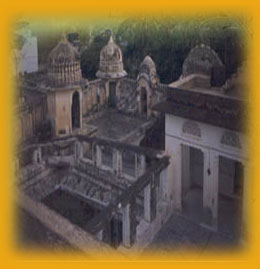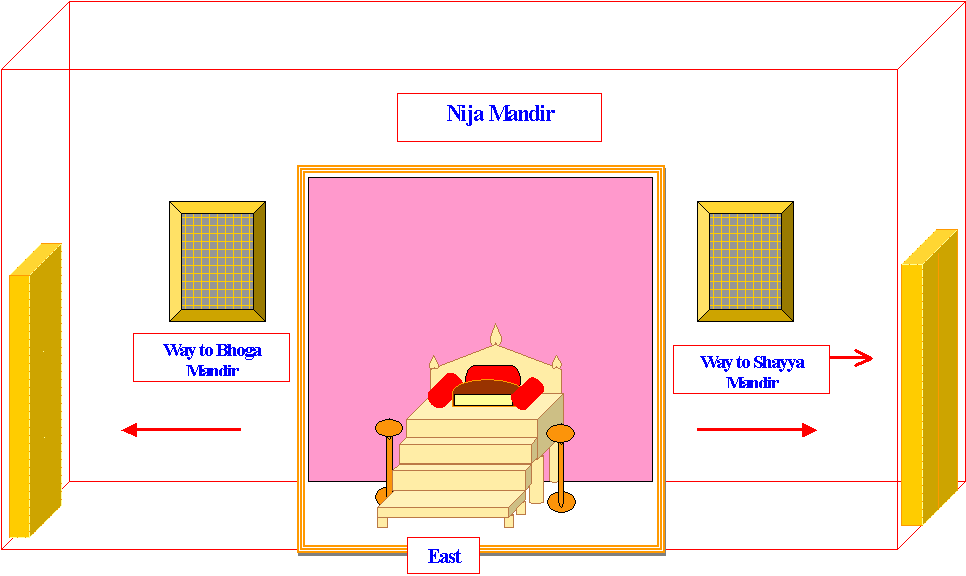
The buildings or structures referred to as the HAVELIS in India are type of Mansions more or less like palaces but are smaller in size and overall grandeur or monumentality. Nonetheless they do posses a certain unique characteristics homely warmth reflecting the involvement of its habitants as per their very personal taste and requirements. These structures are found all over India but those found in the state of Rajasthan indeed excel those from the other states. The city of Jaisalmer has acquired a unique place on the map of world tourism mainly because of its Havelis and Fort built in yellow stone.
Here in this article we shall only deal with the Haveli buildings built for Goswamis of Shri Vallabh clan, by themselves or by their followers most of whom were rulers of small or bigger territories in India.
Sakhadi Kitchen: Anasakhadi Kitchen:

A common belief prevalent that these structures existed right from the time of Shri Mahaprabhuji (Vallabh) is not very correct. It was perhaps during the times of Aurangzeb or a little earlier that Goswami Balaks were compelled to seek safer territories to carry on with their prescribed or desired way of living and most of them were sheltered by small and big Hindu rulers of that time who were followers of Shri Vallabh’s Sampradaya. There could be varied tales of such migration and certain other related factors but the harassment of the intolerant regional Muslim rulers had been a root cause of such exodus from Gokul ,Virndavan and Mathura etc. and that can hardly be disputed.
The work of designing a building commences with a conceptualization and ends with articulation of all such elements which makes a building habitable or any such other function it is supposed to serve. The space and time plays a vital role in this particular field of human indispensability.
In architectural designing certain subtle phenomenon also takes place in its visualization, like an artistic preoccupation reflects in the house of an artist. Botanist’s obsession could be seen in his residence also. Similarly, besides Vastu-shastra, social, economical and political conditions, factors like tenets of the sect, devotional sentiment of the follower, course of Shri Krshna worship, rules of purification etc. have played major role in making architecture of Shuddhadvaita Pushtibhakti Sampradaya of a unique kind. Since each and every, abovementioned, factor reflects in the architecture of Pushti-bhakti-marga, it is very much necessary to have knowledge of all above factors in detail to understand its architectural uniqueness.
Tenets of the sect:
Ultimate goal of the life of follower of Shuddhadvaita Pushtibhakti Sampradaya remains in Shri Krshna worship. Every action may it be sleeping, bathing, dressing, eating, or walking; every part of the day may it be morning, afternoon, evening or night; and every phase of his life may it be childhood-adulthood, job-retirement etc. or may it be an occasion of birth, marriage, birthday, coming-going, business-fun or anything must be centered around Shri Krshna. However, this is his inner feeling, which by no way he would like to express in his outer social life. He would prefer to be recognized in his outer life as a layman despite a devotee. Therefore, he has to maintain delicate balance between his two lives the devotional inner life and the social outer life. By his inner life he is a loving and dedicated servant of Shri Krshna first and then only a householder, father, husband, friend, boss, neighbour etc. Whereas, from the point of view of his outer life, the situation is exactly reverse i.e. very first he is a householder, father, husband, friend, boss, neighbour etc. and secondly a devotee of Shri Krshna. This is the reason why the major area of the residence of the follower of Pushti-bhakti-marga is being spared for Shri Krshna worship where he utilizes most of his time.
Devotional sentiment of the follower:
So much so the worship of Shri Krshna in this sect is entirely private by its nature. Therefore, it is very strictly said that worship of Shri Krshna must be performed in such a private way that no other could even see it. To the extent that if some member of one’s own family does not have such devotional sentiment then, if possible, one should avoid to perform worship in front of him and should not let him behold ones deity. Worship of a year becomes futile if deity is seen by mistake by on who is not Vaishnava. As atonement deity should be purified by Pamchamruta Snan (a special kind of bath by five stuff i.e. milk, cured, ghee, sugar and honey. All in unequal quantity) says Shri Harirayacharana, an eminent Acharya of this sect. Therefore, in order to obey, as far as possible, the above mentioned principle of private worship, the place of worship is kept separate from the residence within the area of the house. One has to bath again if he goes out of the area of worship place. Simultaneously, one, may it be a member of the family or the main worshiper himself, who has not purified himself cannot enter in the area of worship place. Such rules are forced to preserve sanctity of the worship, restrict outsiders to enter in the area of worship and to enhance concentration of the devotee in worship. It is the strongest conviction of the devotee that no body is over and above Shri Krshna. Shri Krshna is the supreme God of the gods. This sense of the highest respect reflects in building of the residence by not constructing any residential place to stay over the section of worship. Invariably upper floor of the worship area is kept vacant or spared for the storage of the things that are used in the course of worship.
Course of Shri Krshna worship:
The course of worship in Shuddhadvaita Pushtibhakti Sampradaya is structured on the model of the life style of Shri Krshna described in scripture like Bhagavat. During the course of worship, festivals like Sanzi, Hindora, Hori etc. are also celebrated as the inhabitant of Vraj province used to celebrate them. Festivals like Gopashtami, Divari, Govardhana-puja, Annakuta etc. that are connected with some or other incidents that happened in the time of Shri Krshna are also celebrated. Festivals like Shri Krshna Jayanti, Rama Jayanti, Vaman Jayanti, Nrasimha Jayanti etc., which are celebrated in Vaishnava tradition in general, as per the instruction of Vaishnav Tantra scriptures, are also celebrated. Moreover, certain festivals that are specifically related to the tradition of this sect such as birthday of Acharyas and family members, Pavitra etc. are also celebrated. Seasonal festivals like Nauka Vihar, Fool Mandali, Khas-khana in summer etc. are celebrated for the comfort of the deity. Over and above this the devotee himself by his independent will offers some special treatment (Manoratha) to his deity during worship lavishly. It should be remembered here that these are not a compulsory rituals. If one wants to do this and if one is able to do this he can do it at his level best. At maximum or minimum level.
All abovementioned festivals and mode of worship require a specific type of construction. Equipments like Chandova, Pichavai, Singhasan, Khanda, Pat, Chauki, Shayya, Hindora, Nav, Sanzi, Chatthi, Bangala, Palana, Ratha etc. that are used daily and/or occasionally in the worship also require construction that is best fitted to them. Cows are brought before deity on some occasions (once or twice a year). Therefore, passage from cowshed to the worship place and flooring of that route is also constructed accordingly. On the occasion of full moon (Shard-purnima), deity is pleased with the moonlight. For this occasion, comes once in a year, special arrangements are made with the consideration of time, direction, throne of the deity etc. during the construction of worship place. A garden with a small Bungali of marble is planned for some occasions.
Rules of purification:
Worship should be performed in the purest state and by the purest available things this is the cardinal principle of this sect. Since Shuddhadvaita Pushtibhakti Sampradaya is an offshoot of Hindu religion, rules of purification are as it is accepted as they are narrated in the Hindu scriptures. Water of well is considered to be the purest water after the water of lake, river or falls. Therefore, the facility of well-water is found at almost all older houses. Moreover, water is used in bulk quantity therefore overhead tank; small storage tanks in kitchen and near bathroom, pipes and taps are designed accordingly. Under ground big water storage tanks are constructed especially in the region like north-west Rajasthan, Saurashtra and Kutch of Gujarat where water scarcity persists. Utensils are cleaned by mud so sink, drainpipe and cesspool are designed distinctively. After the completion of eclipse or after seeing face first time of the newborn baby holy bath is recommended in the scriptures. This bath is preferred to be done in sea, lake, river or in step-well. As per the social custom lady members of the family do not bathe in public places. Therefore, besides an ordinary well, step-well also is constructed in the house. Lavatories are constructed outside the main wall of the house. Tulasi-kyara, container made of stone for the plant of Tulasi is built. During festivals like Janmashtami etc. Shahanai and Nagara are played. Therefore, Nagar-Khana, the place where musicians sit and play Shahanai and Nagara, is specially constructed on top of the main gate of the house. Nagar-Khana is not used for esidential purpose and specific portion of its floor is kept un-constructed.
In the map of worship-place it can be seen that nothing could be seen from outside. However, free passage of light and air is planned remarkably well. Inside the worship-place, in the middle, there is kept a Chawk (square courtyard with open sky) surrounded by three arched-door galleries called ‘Tibari’. Behind one of such galleries is the inner chamber called ‘Nija-Mandira’. At one side of Nija-Mandira sleeping-apartment or ‘Shayana-griha’ is constructed always in the most artistic fashion. On the other side is kept the ‘Bhoga-griha’, dining apartment, where the deity is offered Bhoga-food etc. Beyond the Bhoga-griha kitchen is located, where food to be offered to the deity is prepared. Separate rooms are kept for preparation of flower-garlands, vegetables, betel-leaves, baths, store room of food grain, dry-fruits etc., known as ‘Fula-griha’, Shaka-griha’, ‘Pana-griha’, ‘Jala-griha’ ‘Bhandar’ respectively. Valuable ornaments and dresses with which the deity is adorned are kept in a safe place called ‘Tosa-khana’. Adjacent to the worship area, at some convenient place, dwelling place is constructed.

